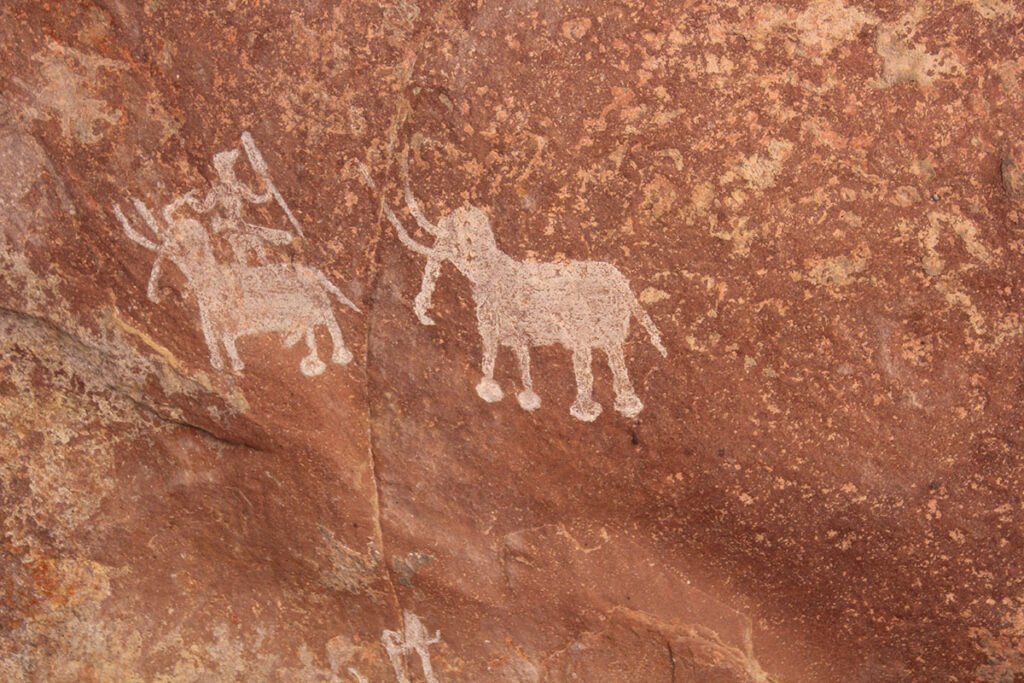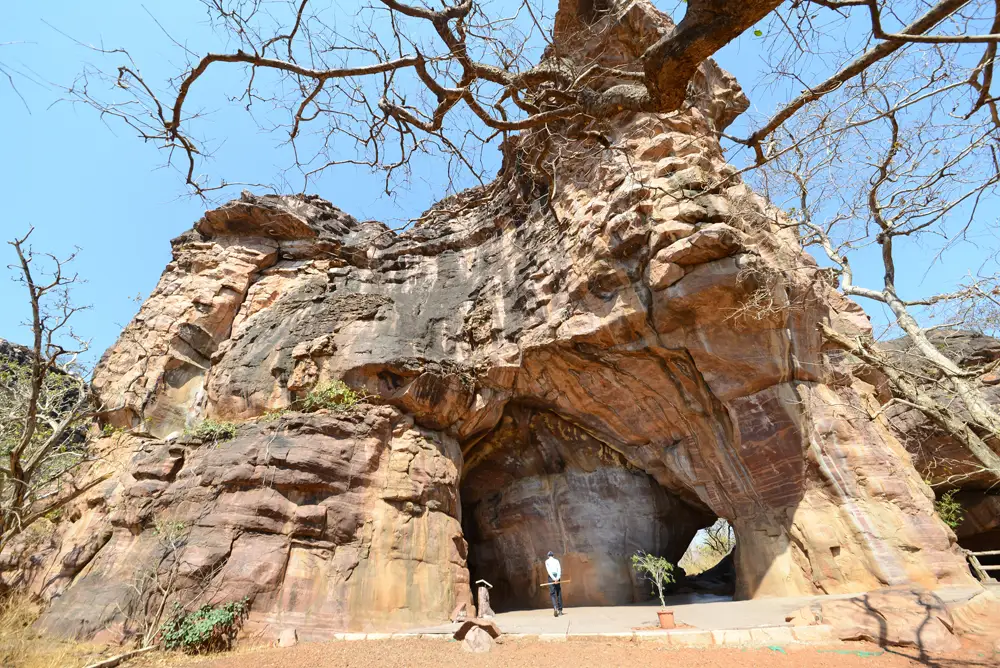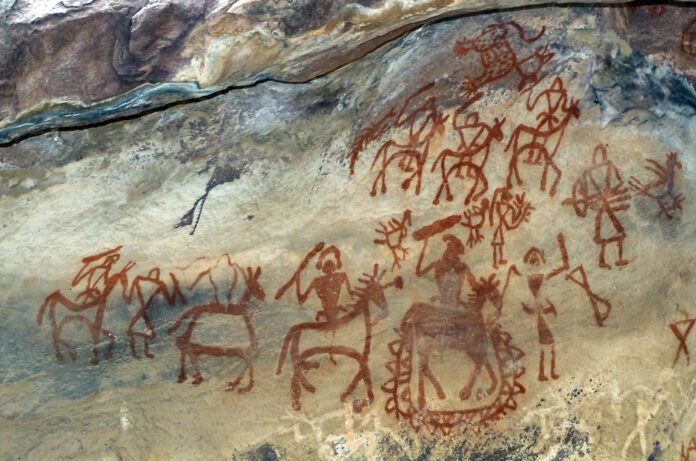Introduction – Echoes from an Ancient Canvas
Bhimbetka Rock Shelters, nestled at the edge of the Vindhya Range in Madhya Pradesh, India, is a gateway to our prehistoric past. Imagine stumbling upon over 750 rock shelters, where centuries of human expression are frozen in time. These shelters, home to ancient cave paintings, reveal a story that stretches back as far as 40,000 BCE, offering glimpses into the lives of hunter‑gatherers, ritual practices, and early human spirituality
1. Discovery – The Hidden Gallery Comes to Light

In 1957, archaeologist V. S. Wakankar spotted strange formations near Bhopal and decided to explore. The result? A spectacular cache of prehistoric rock art, later affirmed by UNESCO in 2003 as a World Heritage Site en.wikipedia.org+1atlasobscura.com+1. What Wakankar discovered changed our understanding of human history in South Asia forever.
2. Geological Setting – Shelters in Stone

The shelters lie amid massive sandstone outcrops shaped by time and weather. Sandstone cliffs form natural alcoves and crevices—perfect canvases protected from erosion. Of the seven hills in the area (e.g., Bhimbetka, Lakha Juar, Muni Babaki), about 400 shelters feature paintings, while others contain engravings or ancient cupules—depressions nearly 100,000 years old, marking some of the earliest human-made rock alterations fr.wikipedia.org+2en.wikipedia.org+2en.wikipedia.org+2.
3. Chronology – Layers of Human History

Scholars divide Bhimbetka’s artwork into nine phases across three broad periods:
- Phase I–V: Mesolithic – early hunter‑gatherer life.
- Phase VI: Chalcolithic – dawn of early agricultural settlements.
- Phase VII–IX: Historic – emergence of ritual, spirituality, and civilization britannica.com+13mapacademy.io+13worldheritagesites.net+13.
Some caves may even date the earliest art to 40,000 BCE rockartscandinavia.com+2en.wikipedia.org+2mapacademy.io+2, making Bhimbetka among the oldest rock‑art sites in Asia.
4. The Art – Motifs and Meanings

a. Animal Imagery
Cave walls depict wildlife: elephants, gaur (wild ox), deer, boars, rhinoceros, monkeys, snakes, tigers, and peacocks. The Zoo Rock shelter, a hub of biodiversity in art form, features them all mapacademy.io+12asi.nic.in+12en.wikipedia.org+12.
b. Human Figures & Movement
Poised hunters with bows, dancers moving in trance‑like formations, women gathering honey or digging for roots—each scene vibrates with energy and social context asiaresearchnews.com+3mapacademy.io+3artsandculture.google.com+3.
c. Mythical & Ritual Scenes
One shelter portrays a giant horned boar chasing a man and a crab, often interpreted as ritual or mythic narration rockartscandinavia.com.
d. Historic Period Imagery
As time progresses, figures shift from animals to humans and symbols of emerging religion: warriors with swords and shields, horse riders, and deities like Shiva, Ganesha, or Mother Goddess, alongside trishuls and swastikas mapacademy.io.
5. Techniques & Materials

Pigments came from iron oxide (ochre) and local plant sources. Brushes were crafted from bird feathers, animal hair, twigs, or simply fingers. Three application styles are observed: transparent wash, opaque colour mix, and crayon‑like direct drawing. Transparent styles dominate, followed by opaque and rare crayon lines rockartscandinavia.com.
6. Storytelling Through Layers
Bhimbetka’s walls are not static—they are overwritten time and again through overlapping art. These layers reveal cultural transitions from hunting‑gathering to agricultural and eventually historic societies. Visible depth conveys a dialogue across millennia britannica.com+13mapacademy.io+13en.wikipedia.org+13.
7. Notable Caves and Shelters

- Auditorium Cave: cathedral‑like space with Gothic arches and Chief’s Rock, a vertical boulder with cupule markings. It stands as Bhimbetka’s spiritual and artistic nucleus jehannuma.com+2en.wikipedia.org+2artsandculture.google.com+2.
- Zoo Rock: densely painted shelter with wildlife, human activity, and ritual depictions across eras en.wikipedia.org+8asi.nic.in+8mapacademy.io+8.
- Boar Rock: iconic mythical boar scene, symbolizing ritualistic and mythic narratives asi.nic.in.
8. Cultural Connections
Bhimbetka’s art resonates with traditions in local tribal societies—the Gonds and Korkus—who continue rituals at these sacred sites. Cultural continuity flows through performance, festivals, and ancestral narratives worldheritagesites.net+10whc.unesco.org+10rockartscandinavia.com+10.
9. Preservation Over Time
The deep shelters, overhead canopies, and sandstone properties shielded the art from elements. Since 1990, the Archaeological Survey of India has managed the site, ensuring visitor access and conservation. In 2003, UNESCO added Bhimbetka to its World Heritage list under criteria that affirm its unique cultural legacy asi.nic.in+2en.wikipedia.org+2en.wikipedia.org+2.
10. Visiting Today – Encountering the Past
When you arrive at Bhimbetka, dense forest opens into rocky caverns echoing with human creativity. A knowledgeable guide illuminates the significance of each motif: from the peacock—symbol of fertility—to the cupules—ancient spiritual marks.
The paintings—ranging from Mesolithic hunters gathering honey to historic dancers—are real time‑capsules that connect you to prehistoric humanity asi.nic.in+3jehannuma.com+3whc.unesco.org+3.
11. Why Bhimbetka Matters
- Art history: earliest rock‑art in South Asia.
- Cultural timeline: chronicles human evolution from Paleolithic hunters to historic societies.
- Archaeological insight: informs on tools, rituals, beliefs, ecology, and social structure.
- Heritage link: living traditions of tribal communities today echo the art you see.
- Conservation model: natural rock shelters have helped conserve art for tens of thousands of years.
12. Story‑Driven Tour – A Walk in the Past
“Morning light filters through tree canopies as you enter the Auditorium Cave, its sandstone floor echoing your footsteps. Chief’s Rock—a silent guardian—stands tall. You imagine the first artist dipping crude brushes into ochre water, painting a hunter or dance in green.”
As you step deeper, the Zoo Rock comes alive: deer chase beneath faded humans, elephants loom in silhouette, monks’ inscriptions whisper from Post‑Gupta times. Brushes of plant fibre, fingers smeared in mud paint—ancient artists communicating across eras.
In Boar Rock, your breath catches: a mythical beast looms, dwarfing a human figure. Is this ritual? Warning? Mythic tale? Layers of later artwork, red soldiers with swords, hover above older scenes.
You close your eyes and hear drums. Tribal music, ancient dances come alive—heritage that still pulses in local rituals.
13. Tips for Visitors
- Hire a local licensed guide for context and interpretation.
- Visit early morning or late afternoon for best light.
- Respect cave etiquette—no touching, limited flash photography.
- Carry water and sturdy shoes—terrain is rugged and uneven.
- Explore Bhopal’s museums (e.g., Tribal Museum) for additional context.
14. Conservation – Balancing Access and Preservation
Conservationists monitor humidity and limit visitor impact. Ongoing efforts include site documentation, weatherproofing, and engagement with tribal communities to uphold both heritage and living traditions.
15. Conclusion – A Living Chronicle
Bhimbetka is more than a tourist site—it’s a living chronicle of human consciousness etched in stone. In those deep, silent shelters, you don’t just see paint—you feel the pulse of past civilizations, their rituals, struggles, and celebrations. Each brushstroke whispers “we were here.” Each shelter holds pieces of our shared human story.
For More Ancient Related Post Please check this out -> Ancient-Egyptian-Hieroglyphs
